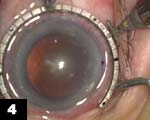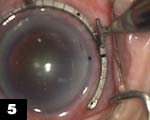Astigmatism management vital for successful refractive lens exchange
Louis D. Nichamin, MD, explains how to manage existing astigmatism using a clear corneal phaco incision.
We have dedicated the past two columns to the treatment of presbyopia. First I described blended vision implants. I stressed that this approach is much more than the IOL version of monovision because of the property of pseudoaccommodation inherent in IOLs. The amount of pseudoaccommodation — about 0.75 D in my own experience — enables the critical interocular difference to be reduced by the same amount. Thus, most full presbyopia can be completely neutralized with an interocular defocus not of 3 D but usually 2 D or less, an amount well below almost every patient’s symptom threshold. (For details, see the November 15, 2003 column.)
In last month’s column, Dr. Bruce Wallace described the patient selection criteria and other nuances of successful Array lens (Advanced Medical Optics) use for treating presbyopia in appropriate refractive lens exchange and cataract patients.
These approaches to presbyopia (blended vision implants and multifocal IOLs) are well established with excellent long-term results. They require no untested techniques or technology. Of course it is quite possible that accommodating IOLs may someday eclipse both, but this new technology will require several iterations and more time (several years, I suspect) before we can say it is able to contend with either of these.
My point is that those who are waiting for the accommodating IOL to be the sole catalyst for the transition to refractive lens exchange are overlooking two approaches that have proved to be successful presbyopia procedures. Should accommodating IOLs show significant benefits over these approaches, then you will be much better prepared to incorporate this new technology as an experienced refractive lens exchange surgeon than as a neophyte.
Astigmatism management
With that we will leave presbyopia for the time being and turn to astigmatism management, another key facet of refractive lens exchange. Recall that we are in the process of discussing each of the prerequisites required to make a smooth transition from refractive cataract surgery to refractive lens exchange, as previously outlined. These prerequisites again are my own:
- Presbyopia must be addressed to the patient’s full satisfaction;
- Astigmatism must be fully managed to assure less than 1 D;
- IOL calculation must be accurate to within ±0.25 D of target (±0.5 D for ametropia greater than 8 D); and
- There must be a near zero incidence of capsular rupture.
Our plan is to continue considering the specific “how-to” techniques involved in meeting all four of the above prerequisites before moving on to the other aspects of making a smooth transition to lens-based refractive surgery.
Today’s column, by Dr. Louis “Skip” Nichamin, is the first of two dealing with astigmatism management. Skip has regularly taught the astigmatism management section of our course and has been very instrumental in making intraoperative surgical astigmatic correction an integral part of refractive cataract surgery and now refractive lens exchange. I do not know anyone better to teach us the specifics involved in meeting this second prerequisite: The final astigmatism result must be less than 1 D.
by Louis D. Nichamin, MD
OSN cataract surgery board member
Over the past decade, a great deal of effort has centered on the study of the astigmatic effects of various cataract incisions. By manipulating incision parameters (size, location and shape), surgeons could, with a reasonable level of accuracy, “tailor” their astigmatic outcome according to the patient’s existing astigmatism. This on-axis, variable incisional approach, however, does require effort rotating about the operating room table and may result in awkward hand positions.
Recent advances in incisional technique and implant technology now allow for a different approach in managing astigmatism during phacoemulsification surgery. Specifically, the temporal clear corneal phaco incision, as popularized by Dr. Howard Fine, has proved to be safe, effective and remarkably reproducible. Additionally, as a result of improvements in foldable IOL delivery systems, implantation may now be routinely performed through incisions of 3 mm to 3.2 mm.
Well-documented studies support the clinical impression that incisions of this size behave in an essentially astigmatically neutral fashion. Thus, an incision may now be easily and reproducibly crafted to yield all of the benefits of the clear corneal approach, and it is astigmatically neutral. If a patient has enough existing astigmatism to warrant reduction, then additional surgery may be superimposed, concurrently or at a later time, on this temporal clear corneal phaco incision. Today, this most commonly takes the form of (intra-) limbal peripheral arcuate astigmatic relaxing incisions (LRIs). Other options include toric implants or a “bioptics” approach using excimer or other nonlaser technology to enhance the refractive outcome.
Our use of LRIs originated from the work of Dr. Stephen Hollis. With further refinement of his nomogram, we have found this peripheral approach to astigmatic keratotomy to be considerably more forgiving with less induced shift of resultant cylinder axis, greater predictability and, perhaps most importantly, less tendency to induce irregular corneal astigmatism when compared with corneal incisions placed at smaller optical zones. Another advantage of moving out to the limbus involves the “coupling ratio,” which describes the amount of flattening that is induced in the incised meridian relative to the amount of steepening that occurs 90° away. LRIs exhibit a consistent 1:1 ratio, and therefore negligible change in spheroequivalent occurs, obviating the need to adjust the IOL power
Table 1: Nomogram for clear corneal phaco surgery based on astigmatic status |
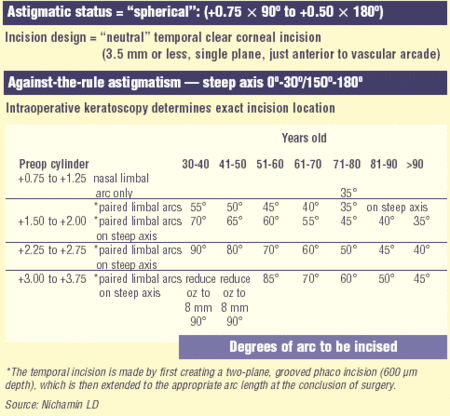 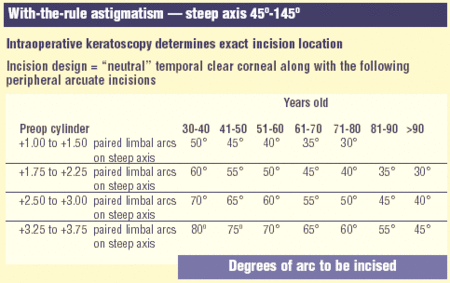 |
Surgical plan
It is generally agreed that mild, residual with-the-rule astigmatism is desirable (when using monofocal IOLs), overcorrection (axis shift of 180°) is undesirable, and the refractive plan must take into account the status of the fellow eye. With this in mind, surgery is planned according to the nomogram (Table 1). Unfortunately, preoperative measurements (keratometry, refraction and topography) do not always agree. Lenticular astigmatism may account for some of this disparity; however, our experience supports the notion that traditional measurements of astigmatism, particularly those obtained with standard keratometry (only two points measured in each meridian), do not always adequately quantitate the amount of astigmatism present.
We have found that keratometry generally provides an accurate determination of axis and refraction provides a more reliable indicator of the quantity of cylinder. When conflicting measurements do arise, one can compromise and average the disparate readings or simply defer the relaxing incisions until a stable postoperative refraction is obtained since this technique lends itself nicely to in-office “touchups.” Corneal topography may be called upon as the “tiebreaker” and may disclose underlying corneal pathology that might dissuade the surgeon from employing LRIs. Once the amount of astigmatism has been determined, the nomogram is used by aligning the age and preop cylinder columns. Incisions are typically paired to optimize symmetric corneal flattening and expressed in degrees of arc rather than millimeters since corneal diameter may significantly affect the relative length of the arcuate incision and its resultant effect.
Surgical technique
Many surgeons advocate placing an orientation mark at the 12 o’clock or 6 o’clock limbus before adopting the supine position. This is particularly important when using injection anesthesia. In either event, some form of intraoperative keratoscopy is recommended to verify the steep meridian over which the incisions will be centered. It is reasonable to place all astigmatic keratotomy incisions at the conclusion of surgery in the event that a complication necessitates a modification to the phaco incision. For routine cases, however, I prefer to place these incisions at the outset in order to avoid epithelial disruption.
One exception would be in the case of high against-the-rule astigmatism wherein the nomogram calls for a temporal arcuate incision of greater than 40°. Since this incision or “deep groove” will be superimposed upon the phaco tunnel, if it is extended to its full arc length at the start of surgery, significant gaping and edema may result secondary to intraoperative manipulation. In this situation, the temporal incision is made by first creating a two-plane, grooved phaco incision (600-µm deep), which is then extended to the full arc length, as determined by the nomogram, at the conclusion of surgery. The nasal arc may be extended to its full arc length at the beginning of the case. Note that the keratome used for the phaco tunnel is inserted through the temporal LRI by pressing the bottom surface of the blade downward upon the outer or posterior edge of the LRI and then advancing the keratome at an iris-parallel plane.
| Table 2: The NAPA nomogram (Nichamin age and pach-adjusted intralimbal arcuate astigmatic nomogram) |
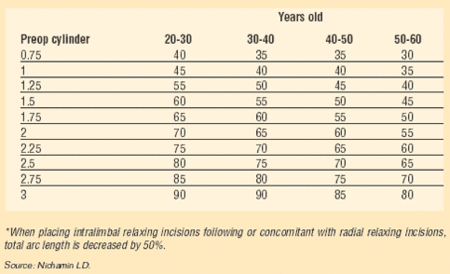 |
The LRIs are placed at the most peripheral extent of clear corneal tissue, just inside of the true surgical limbus, irrespective of the presence of vessels or pannus. An empiric blade depth setting of 600 µm is used in the setting of concomitant cataract surgery. Prior studies employing pachymetry and adjusted blade settings yielded negligible benefit in this older population, as opposed to younger refractive surgery patients where variable blade depth settings are justified along with a slightly more aggressive nomogram. Diamond blade style and configuration may require an adjustment in depth settings. Several new diamond knives designed specifically for this type of relaxing incision are now available. My personal preference when performing routine cataract surgery is for an instrument designed by Mastel Precision. It uses a single arced footplate to improve visibility, and the diamond extends to the appropriate preset depth (600 µm). Similar designs are available from Rhein Medical, ASICO and other companies. I would stress that in the setting of a refractive lens exchange, greater accuracy may be achieved by performing pachymetry over the entire intended incision site. An adjustable micrometer blade is then set at 100% of the thinnest reading obtained, and incision length is determined by the NAPA Nomogram (Table 2).
The extent of arc to be incised may be demarcated in several different ways. My preferred method makes use of a specially designed Fine-Thornton Fixation Ring that both fixates the globe and allows one to delineate the extent of arc by visually extrapolating from the limbus to the adjacent marker (Mastel Precision, Rhein Medical and Storz). Each incremental mark is 10° apart, and bold hash marks 180° apart serve to align with the steep axis. This approach avoids inking and marking of the cornea. If desired, a two-cut RK marker may be used to mark the exact extent of arc to be incised in conjunction with the fixation ring/gauge. Alternatively, various press-on markers are available, such as those made by Rhein Medical (Nichamin-Kershner LRI Markers or the Dell-Nichamin Marker). A Mendez ring and gauge is another alternative to delineate the extent and location of the incisions (Rhein Medical). Attention to detail is important in achieving a good result surgically (Figures 1 to 5).
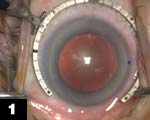 | 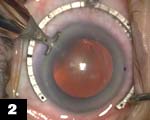 | |
In this case, the nomogram calls for LRIs of 45° to 50° of arc over the steep 85° meridian. Each incremental mark on the ring equals 10°. The surgeon therefore counts over 25° to one side of the centering hash mark. Note 6 o’clock orientation mark at the limbus. | The blade is inserted. | |
|
|
|
| (Photographs courtesy of Louis D. Nichamin, MD.) | ||
Alternatives to LRIs
Other options to reduce existing astigmatism include use of a toric IOL. In theory, this is an attractive alternative to relaxing incisions but one that has been slow to catch on in the United States, perhaps due to a limited number of approved implant designs. A toric IOL in combination with relaxing incisions may be used to successfully treat high levels of astigmatism.
The term bioptics was originally proposed by Dr. Roberto Zaldivar to describe the use of LASIK to reduce residual spherical and astigmatic error after myopic phakic IOL surgery. A similar approach may be taken after pseudophakic implantation and is proving to be a safe and effective technique in our hands. Most recently, we have begun to employ conductive keratoplasty as an enhancement tool to refine refractive outcomes. This off-label use of CK is logistically attractive as an in-office procedure and is most suitable for residual hyperopic astigmatism. As opposed to relaxing incisions, CK spots are placed in a radial fashion over the flat meridian.
Conclusion
Our experience utilizing peripheral, intralimbal arcuate relaxing incisions over the past decade has paralleled that of many other surgeons and has proved to be a safe and effective means to reduce existing astigmatism. Other options include the use of a toric implant or other keratorefractive techniques, including the excimer laser or CK.
Next month
Why comprehensive astigmatism management is such an important part of successful refractive lens exchange.
For Your Information:
- Louis D. Nichamin, MD, can be reached at Laurel Eye Clinic, 50 Waterford Pike, Brookville, PA 15825; 814-849-8344; fax: 814-849-7130; e-mail: nichamin@laureleye.com. Dr. Nichamin has no financial interest in the products mentioned in this article. He is a scientific adviser for Refractec.


